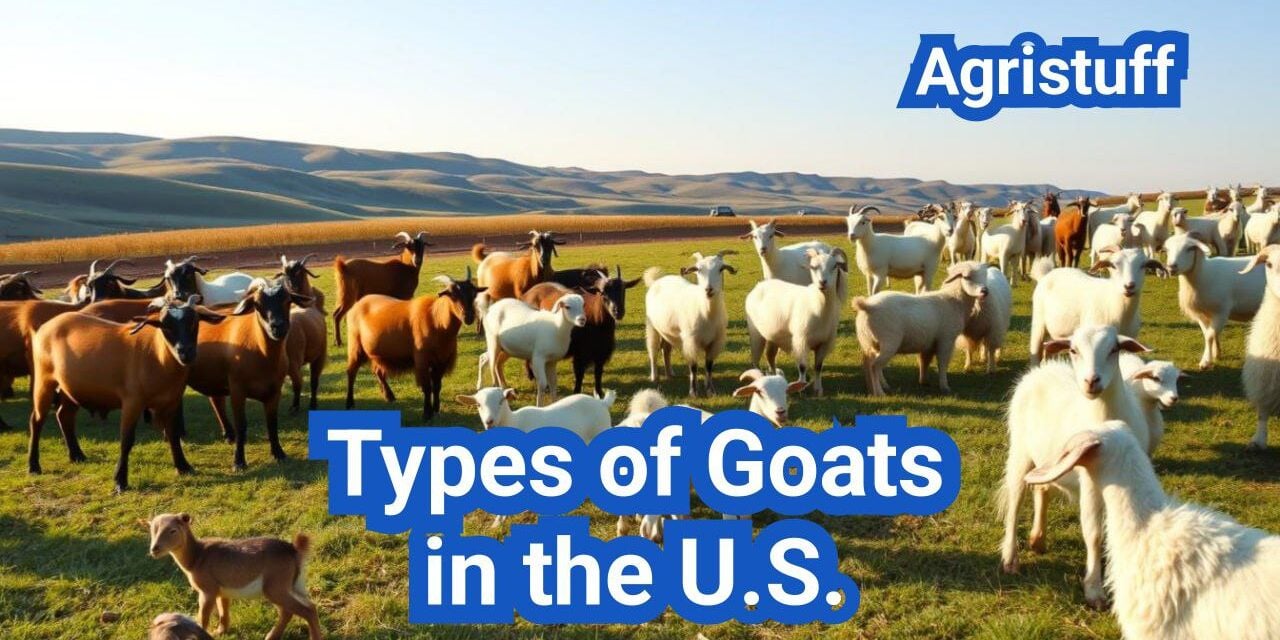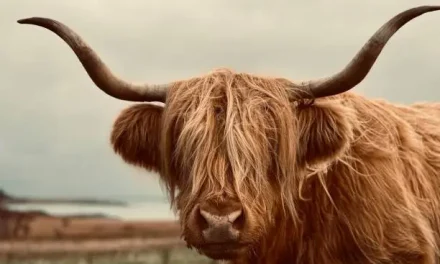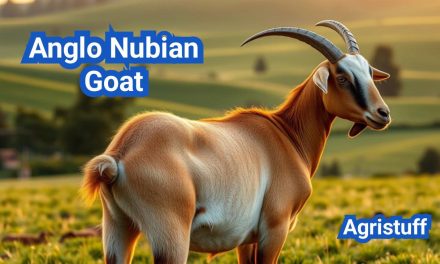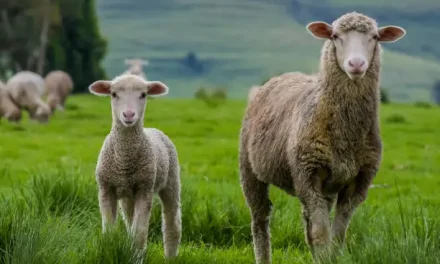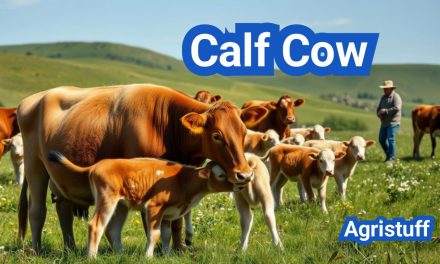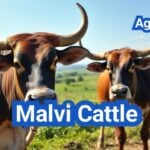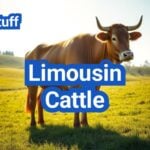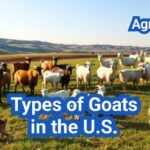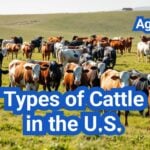The United States is home to a diverse range of goat breeds, each with its unique characteristics and uses. Goat farming has become increasingly popular, with farmers and breeders raising goats for meat, milk, fiber, and as pets.
There are four basic categories of goats: dairy goats, which are milked for their milk; meat goats, which are raised for their muscular build; fiber goats, which are prized for their soft fleece; and pygmy goats, which are small in size and often kept as pets.
Understanding the different characteristics of these goat breeds is essential for farmers, breeders, and enthusiasts. This knowledge helps in selecting the right breed for specific purposes, ensuring the success of goat farming endeavors.
Key Takeaways
- There are four main categories of goats in the U.S.: dairy, meat, fiber, and pygmy goats.
- Dairy goats are raised for their milk, which can be consumed or made into dairy products.
- Meat goats are known for their muscular build and are raised for meat production.
- Fiber goats are prized for their soft fleece, used to produce fiber products.
- Pygmy goats are small in size and often kept as pets or used for milk and meat production.
Understanding the Goat Industry in the United States
The goat industry in the United States is a multifaceted sector that encompasses various breeds and products, contributing significantly to the country’s agricultural economy. This diversity allows the industry to cater to a wide range of consumer demands, from meat and dairy products to fiber.
Current USDA Goat Inventory Statistics
The USDA conducts regular surveys to assess the goat inventory across the United States. According to recent data, the number of goats on farms has shown a steady trend, reflecting the industry’s stability and growth potential. For instance, in 2020, Indiana alone reported 14,000 milk goats and 38,000 meat and other goats on farms.
To better understand the goat inventory, let’s examine the distribution across different states and the types of goats being raised.
| State | Milk Goats | Meat and Other Goats |
|---|---|---|
| Indiana | 14,000 | 38,000 |
| Other States | Varies | Varies |
Economic Impact of Goat Farming
Goat farming has a significant economic impact on the agricultural sector in the United States. The industry provides employment opportunities, generates income for farmers, and contributes to the national GDP. The economic benefits of goat farming are multifaceted, ranging from the sale of goat products to the creation of jobs in related industries.
The American Boer Goat Association, established in 1993, is a testament to the growing importance of goat farming. The association’s efforts in promoting Boer goats, which were first imported to the U.S. from Australia and New Zealand in 1993, have contributed to the development of the meat goat industry.
Growing Popularity of Goat Products
The demand for goat products, including meat, milk, and fiber, has been on the rise in recent years. Consumers are increasingly seeking out goat products due to their perceived health benefits, unique flavors, and versatility in culinary applications. This growing popularity has driven the expansion of the goat industry, with farmers responding to market demands by diversifying their operations.
As the industry continues to evolve, it is likely that we will see further innovations in goat products and production methods, catering to the changing needs and preferences of consumers.
Different Types of Goats: Classification Overview

Understanding the different types of goats is crucial for farmers and consumers alike. Goats are classified into various categories based on their primary use, such as dairy, meat, fiber, and pygmy breeds. This classification helps in understanding the characteristics and purposes of different goat breeds.
Purpose-Based Classification
Goats are primarily classified based on their purpose into dairy, meat, fiber, and pygmy breeds. Dairy goats are bred for their milk, which is used to produce cheese, butter, and other dairy products. Meat goats are raised for their meat, which is consumed in various forms. Fiber goats are valued for their hair, which is used to produce mohair, cashmere, and other types of fiber. Pygmy goats are often kept as pets or used in conservation grazing.
The purpose-based classification is essential for farmers to choose the right breed for their specific needs. For instance, dairy farmers focus on breeds like Alpine, Nubian, and LaMancha, known for their high milk production. Meat producers, on the other hand, prefer breeds like Boer, Kiko, and Spanish goats, which are known for their hardiness and growth rates.
Breed Standards and Registries
Breed standards and registries play a crucial role in maintaining the purity and characteristics of various goat breeds. Breed associations establish standards for each breed, including physical characteristics, production levels, and other traits. These standards help in identifying purebred animals and ensuring that the breed characteristics are preserved.
Registries are organizations that maintain records of purebred animals. They verify the pedigree of animals and issue registration certificates. This process helps in maintaining the integrity of the breed and provides a way to track the lineage of animals.
Purebred vs. Crossbred Goats
Purebred goats are those that belong to a specific breed and have a documented pedigree. They are bred to maintain the characteristics of the breed. Crossbred goats, on the other hand, are the result of breeding two different breeds. Crossbreeding is often used to combine the desirable traits of different breeds, such as hardiness and high production levels.
| Characteristics | Purebred Goats | Crossbred Goats |
|---|---|---|
| Pedigree | Documented pedigree | Combination of two breeds |
| Traits | Consistent breed characteristics | Combination of traits from both breeds |
| Hardiness | Varies by breed | Often more hardy due to hybrid vigor |
| Production | High production within breed standards | Potential for improved production through crossbreeding |
The choice between purebred and crossbred goats depends on the farmer’s goals and management practices. Purebred goats are ideal for those who want to maintain a specific breed, while crossbred goats can offer advantages in terms of hardiness and production.
Meat Goat Breeds in the U.S.
The United States is home to a diverse range of meat goat breeds, each with unique characteristics and advantages. These breeds have been developed to thrive in various environments and production systems, offering farmers a range of options to suit their specific needs.
Boer Goats: The Premier Meat Breed
Boer goats are one of the most popular meat goat breeds in the U.S., known for their exceptional muscling, growth rate, and carcass quality. Originating from South Africa, Boer goats have been widely adopted in the U.S. for their ability to produce high-quality meat.
Key characteristics of Boer goats include:
- Fast growth rate
- Muscular build
- High-quality carcass
Kiko Goats: Hardy Meat Producers
Kiko goats are another prominent meat goat breed in the U.S., recognized for their hardiness and parasite resistance. Developed in New Zealand, Kiko goats have gained popularity for their ability to thrive in challenging environments.
Advantages of Kiko goats:
- Hardiness and adaptability
- Resistance to parasites
- Efficient foragers
Spanish Goats: Versatile and Adaptable
Spanish goats, also known as “brush goats,” are valued for their versatility and adaptability. They are excellent foragers and have been used in land management practices to control brush and vegetation.
Characteristics of Spanish goats:
- Excellent foraging ability
- Hardy and adaptable
- Good mothers
Savanna and Kalahari Red Goats
Savanna and Kalahari Red goats are other notable meat goat breeds in the U.S., known for their heat tolerance and hardiness. These breeds are well-suited for production systems in hot and dry climates.
Key traits of Savanna and Kalahari Red goats:
- Heat tolerance
- Hardiness
- Good growth rates
When selecting a meat goat breed, farmers should consider factors such as climate, production goals, and management practices to choose the most suitable breed for their operation.
| Breed | Growth Rate | Hardiness | Meat Quality |
|---|---|---|---|
| Boer | Fast | Medium | High |
| Kiko | Medium | High | Medium |
| Spanish | Medium | High | Medium |
| Savanna | Fast | High | High |
| Kalahari Red | Fast | High | High |
Comparing Popular Meat Goat Breeds
Selecting the right meat goat breed is crucial for farm success, with Kiko and Boer being top contenders. When farmers decide to raise meat goats, they must consider several factors, including growth rates, hardiness, and market value.
Kiko vs. Boer: Growth Rates and Hardiness
Kiko and Boer goats are two of the most popular meat goat breeds in the U.S. Kiko goats are known for their hardiness and parasite resistance, making them an excellent choice for farms with challenging environmental conditions. Boer goats, on the other hand, are renowned for their rapid growth rate and superior muscling.
“Kiko goats are often praised for their ability to thrive in harsh environments with minimal input,” according to agricultural experts. In contrast, Boer goats are typically raised in more controlled environments to maximize their growth potential.
Market Value Comparisons
The market value of meat goats can vary significantly based on breed, age, and quality. Boer goats, due to their rapid growth and desirable carcass characteristics, often command a higher price than Kiko goats. However, Kiko goats can offer better returns in certain production systems due to their lower maintenance requirements.
- Kiko goats: Hardy, parasite-resistant, potentially lower feed costs
- Boer goats: Rapid growth rate, superior muscling, potentially higher market price
Choosing the Right Meat Breed for Your Farm
When choosing between Kiko and Boer goats, farmers should consider their specific production goals and farm conditions. Factors such as climate, available forage, and market demand should all be taken into account.
It’s essential to evaluate your farm’s unique conditions and production goals when deciding between meat goat breeds. For instance, farms with challenging parasite issues may prefer Kiko goats, while those with more controlled environments might opt for Boer goats.
As one agricultural specialist notes, “The right breed can make all the difference in the profitability and sustainability of your meat goat operation.”
Dairy Goat Breeds in the U.S.
The United States is home to a diverse range of dairy goat breeds, each with unique characteristics and milk production capabilities. Dairy goat farming in the U.S. is a thriving industry, with various breeds contributing to the production of high-quality milk and dairy products.
Alpine Goats: Consistent Milk Producers
Alpine goats are renowned for their high milk production. They are a popular choice among dairy farmers due to their ability to produce large quantities of milk consistently. Their milk is rich in nutrients and is often used for making cheese, butter, and other dairy products.
Nubian Goats: High Butterfat Content | Different Types of Goats in the U.S.
Nubian goats are prized for their milk’s high butterfat content, making it ideal for producing rich and creamy dairy products. Their distinctive ears and gentle nature also make them a favorite among many dairy goat breeders.
LaMancha Goats: The American Dairy Breed | Different Types of Goats in the U.S.
LaMancha goats are known for their easy-going nature and high milk production. They are an American breed developed for their dairy capabilities, with a focus on producing milk with high protein and butterfat content.
Saanen and Toggenburg Goats | Different Types of Goats in the U.S.
Saanen goats and Toggenburg goats are also significant dairy breeds in the U.S. Saanen goats are recognized for their high milk production, while Toggenburg goats are valued for their rich milk and robust health.
Here’s a comparison of the milk production characteristics of these dairy goat breeds:
| Breed | Milk Production (lbs/year) | Butterfat Content (%) |
|---|---|---|
| Alpine | 1,100-1,300 | 3.5 |
| Nubian | 800-1,000 | 4.5-5.0 |
| LaMancha | 1,000-1,200 | 4.0-4.5 |
| Saanen | 1,200-1,400 | 3.5 |
| Toggenburg | 1,000-1,200 | 3.5-4.0 |
Each of these breeds offers unique advantages for dairy production, allowing farmers to choose the best breed or combination of breeds for their specific needs and production goals.
Dairy Goat Milk Production Characteristics
Different dairy goat breeds exhibit unique milk production profiles, including variations in milk fat content and production volume. This diversity allows farmers to choose breeds that best suit their production goals and market demands.
Milk Fat Content Comparisons | Different Types of Goats in the U.S.
The milk fat content is a critical factor in determining the suitability of goat milk for various dairy products. Breeds like the Nubian are known for their high butterfat content, typically ranging between 4.5% to 5.5%, making their milk ideal for cheese production.
In contrast, breeds such as the LaMancha and Saanen tend to have lower milk fat content, usually around 3.5% to 4%, which is still valuable for fluid milk consumption and other dairy products.
Production Volume Expectations | Different Types of Goats in the U.S.
Production volume is another important characteristic that varies among dairy goat breeds. For instance, Alpine and Saanen goats are recognized for their high milk production, often yielding between 2,000 to 2,500 pounds of milk per lactation.
On the other hand, smaller breeds like the Nigerian Dwarf produce less milk, typically around 500 to 800 pounds per lactation, but their milk is rich and creamy, making it suitable for specialty dairy products.
Lactation Duration by Breed | Different Types of Goats in the U.S.
The duration of lactation also differs among breeds. Most dairy goats have a lactation period of about 305 days, but some breeds may lactate for longer or shorter periods.
For example, breeds like the Toggenburg are known for their extended lactation, sometimes lasting over 10 months, which can be advantageous for consistent milk production.
Flavor Profiles of Different Goat Milks | Different Types of Goats in the U.S.
The flavor profile of goat milk can vary significantly between breeds, influenced by factors such as milk fat content and the presence of certain fatty acids.
As noted by dairy experts, “The flavor of goat milk is often described as richer and more pronounced compared to cow milk, with some breeds producing milk that is sweeter or has a more distinct ‘goaty’ flavor.”
Understanding these differences is crucial for producers aiming to create a range of dairy products that cater to diverse consumer preferences.
Fiber Goat Breeds in the U.S.

Among the various goat breeds in the U.S., fiber-producing goats stand out for their mohair, cashmere, and other specialty fibers. These breeds have been gaining popularity for their unique products, which are highly valued in the textile industry.
Angora Goats: Mohair Production | Different Types of Goats in the U.S.
Angora goats are renowned for their mohair production. Mohair is a silk-like fabric made from the hair of Angora goats. It is durable, soft, and has excellent drape. The fleece is harvested through a process called shearing, typically done twice a year.
Mohair Characteristics: Mohair fibers are known for their strength, elasticity, and ability to hold dye well. These characteristics make mohair a popular choice for clothing and upholstery.
Cashmere-Producing Goats | Different Types of Goats in the U.S.
Cashmere-producing goats are prized for their luxurious undercoat, known as cashmere. Cashmere is one of the finest and warmest natural fibers, used in high-end clothing and textiles. The process of harvesting cashmere is labor-intensive, involving combing the undercoat during the molting season.
“Cashmere is renowned for its softness, warmth, and lightweight properties, making it highly sought after in the luxury textile market.”
Pygora Goats: Dual-Purpose Fiber | Different Types of Goats in the U.S.
Pygora goats are a cross between Pygmy and Angora goats, bred for their fiber and meat production. They produce a unique fleece that can be used to create a variety of textiles, from soft, fine garments to durable outerwear.
Pygora Fiber Characteristics: The fleece of Pygora goats is known for its softness, crimp, and color variety, making it versatile for different textile applications.
Harvesting and Marketing Goat Fiber | Different Types of Goats in the U.S.
The process of harvesting goat fiber involves shearing or combing, depending on the breed and type of fiber. Shearing is typically done for Angora goats to harvest mohair, while combing is used for cashmere-producing goats.
Marketing Strategies: Effective marketing of goat fiber involves highlighting the unique qualities of the fiber, such as its durability, softness, and sustainability. Online platforms, local markets, and textile industry events are key channels for marketing these products.
Mini Goat Breeds in the U.S.

Mini goat breeds have gained popularity in the U.S. for their versatility and compact size. These breeds offer a range of benefits for farmers and hobbyists, from dairy production to meat and companionship.
Nigerian Dwarf Goats: Miniature Dairy Producers
Nigerian Dwarf goats are known for their high milk production relative to their size. They are a popular choice for small farms and homesteads due to their compact size and rich milk.
Milk Production: Nigerian Dwarf goats can produce up to 1 quart of milk per day, with a high butterfat content making it ideal for cheese and butter production.
Pygmy Goats: Compact Meat Producers | Different Types of Goats in the U.S.
Pygmy goats are another popular mini breed, often raised for meat. They are hardy and adaptable, making them suitable for various farming conditions.
Characteristics: Pygmy goats are known for their stocky build and robust nature, making them a good choice for meat production.
Miniature Dairy Goat Association (MDGA) Recognized Breeds
The MDGA recognizes several miniature dairy goat breeds, including the Nigerian Dwarf. These breeds are valued for their dairy production capabilities.
- Nigerian Dwarf
- Miniature LaMancha
- Miniature Saanen
Space Requirements and Management | Different Types of Goats in the U.S.
One of the advantages of mini goat breeds is their minimal space requirements. However, they still need adequate fencing and shelter.
Space Needs: A general rule of thumb is to provide at least 1/4 acre per 5-6 mini goats, depending on the quality of pasture and management practices.
Nigerian Dwarf vs. Pygmy Goats: Key Differences

For those looking to raise miniature goats, understanding the differences between Nigerian Dwarf and Pygmy breeds is crucial. Both are popular for their small size, but they have distinct characteristics that make them suitable for different purposes.
Physical Characteristics and Size | Different Types of Goats in the U.S.
Nigerian Dwarf goats are known for their small stature, typically weighing between 20-40 pounds and standing about 17-23 inches tall at the shoulder. They have a slender build and are often described as having a “dainty” appearance. In contrast, Pygmy goats are slightly larger, weighing between 50-75 pounds and standing about 16-23 inches tall. They have a more compact, muscular build.
Temperament and Handling | Different Types of Goats in the U.S.
Nigerian Dwarf goats are often described as friendly, curious, and energetic. They are known to be intelligent and can be trained to walk on a leash or perform tricks. Pygmy goats are also friendly and social, but they can be more stubborn at times. Both breeds are generally good with children and can make great pets for families.
“Nigerian Dwarf goats are known for their intelligence and can be quite entertaining to watch,” says Jane Smith, a seasoned goat breeder. “They require attention and stimulation to prevent boredom.”
Production Capabilities | Different Types of Goats in the U.S.
One of the main differences between Nigerian Dwarf and Pygmy goats lies in their production capabilities. Nigerian Dwarf goats are renowned for their milk production, with some does producing up to 1 quart of milk per pound of body weight per day. They have a high butterfat content, making their milk ideal for cheese and butter production. Pygmy goats, on the other hand, are primarily raised for meat or as pets. While they can be used for milk production, their output is generally lower than that of Nigerian Dwarf goats.
Best Uses for Each Breed | Different Types of Goats in the U.S.
The choice between Nigerian Dwarf and Pygmy goats depends largely on your specific needs and goals. If you’re looking for a dairy goat that can provide high-quality milk, Nigerian Dwarf might be the better choice. If you’re interested in raising goats for meat or as pets, Pygmy goats could be more suitable. Both breeds can thrive in a variety of settings, provided they receive proper care and management.
In conclusion, while both Nigerian Dwarf and Pygmy goats are miniature breeds with their unique advantages, understanding their differences is key to making an informed decision about which breed to raise.
Specialty Goat Breeds for Unique Purposes

Specialty goat breeds offer farmers and homesteaders unique solutions for specific needs, from land management to distinctive characteristics. These breeds are not only interesting but also provide practical benefits for various agricultural purposes.
Myotonic (Tennessee Fainting) Goats | Different Types of Goats in the U.S.
Myotonic goats, also known as Tennessee Fainting goats, are a specialty breed known for their unique condition called myotonia congenita. When startled, these goats stiffen and fall over, a trait that has both fascinated and concerned farmers. Despite this condition, they are hardy and adaptable, making them suitable for certain farming operations.
Their meat is considered tender and flavorful, and they are often used in crossbreeding programs to improve the hardiness of other breeds. Myotonic goats are also relatively easy to handle due to their calm nature.
Spanish Goats for Brush Control | Different Types of Goats in the U.S.
Spanish goats are renowned for their ability to control brush and manage vegetation. They are excellent browsers, consuming a wide variety of plants, including invasive species that other livestock might avoid. This makes them ideal for land management tasks, helping to maintain open spaces and reduce fire hazards.
- Effective in controlling invasive species
- Adaptable to various environments
- Can be used in conservation efforts
Oberhasli Goats: Versatile Swiss Breed | Different Types of Goats in the U.S.
Oberhasli goats are a versatile breed originating from Switzerland, known for their striking color and impressive milk production. They are often used in dairy operations due to their high-quality milk, which is rich in butterfat. Oberhasli goats are also known for their friendly disposition and are relatively easy to manage.
Rare and Heritage Breeds in Conservation | Different Types of Goats in the U.S.
Rare and heritage goat breeds play a crucial role in conservation efforts, preserving genetic diversity and cultural heritage. Breeds like the Saanen and Toggenburg are not only valuable for their historical significance but also for their unique characteristics that can be beneficial in modern farming.
- Preservation of genetic diversity
- Cultural heritage maintenance
- Potential for future agricultural innovations
Different Types of Goats with Horns

The presence of horns in goats is a characteristic that varies across different breeds. While some breeds are naturally polled, others are known for their impressive horns, which serve multiple purposes including defense and establishing dominance within the herd.
Naturally Horned Breeds | Different Types of Goats in the U.S.
Many goat breeds are naturally horned, with horns being a breed characteristic. For instance, breeds like the Boer, Kiko, and Spanish goats are often horned. These horns can grow quite large and are an important feature for the breed’s identity.
Naturally horned breeds are not only aesthetically pleasing but also have practical uses. Horns can be used for defense against predators and for establishing a hierarchy within the herd.
Polled Genetics in Goats | Different Types of Goats in the U.S.
The presence or absence of horns in goats is determined by genetics. The polled trait is often the result of selective breeding. Polled genetics can vary, with some breeds having a higher incidence of polled individuals due to breeding practices.
Understanding polled genetics is crucial for breeders who wish to either maintain or eliminate horns in their goat populations. The genetics behind horn presence is complex and involves multiple genes.
Horn Management Considerations | Different Types of Goats in the U.S.
Managing horns is an essential aspect of caring for horned goats. Regular inspection and maintenance are necessary to prevent horn-related injuries. This includes trimming to prevent overgrowth and checking for any signs of infection or damage.
- Regular trimming to prevent overgrowth
- Inspection for signs of infection or damage
- Proper handling techniques to minimize injury risk
Safety Practices for Horned Goats | Different Types of Goats in the U.S.
Handling horned goats requires specific safety practices to minimize the risk of injury. It’s essential to approach these animals with caution and to be aware of their body language.
Safety practices include being mindful of the goat’s personal space, avoiding sudden movements, and ensuring that handlers are experienced in managing horned goats.
By understanding the characteristics of horned goats and implementing proper management and safety practices, farmers can successfully raise these unique animals.
Getting Started with Goat Farming

Starting a goat farm demands a comprehensive approach, including proper housing, equipment, and animal selection. This foundational step is crucial for the success and sustainability of the farm.
Essential Equipment and Housing | Different Types of Goats in the U.S.
The first step in establishing a goat farm is to provide adequate housing and equipment. Goats require shelter from extreme weather conditions, such as heat, cold, and rain. The housing should be well-ventilated, dry, and protected from predators.
Key Components of Goat Housing:
- Sturdy fencing to prevent escape and predator entry
- Adequate shelter with proper ventilation
- Comfortable bedding such as straw or sand
- Access to clean water and feeding facilities
The quality of housing directly impacts the health and productivity of the goats. Therefore, investing in appropriate housing is a critical initial step.
Selecting Starter Animals | Different Types of Goats in the U.S.
Choosing the right starter animals is vital for the success of a goat farm. Factors to consider include the breed, age, health, and temperament of the goats.
| Breed | Purpose | Characteristics |
|---|---|---|
| Boer | Meat Production | Hardy, fast-growing |
| Nubian | Dairy | High milk production, rich milk flavor |
| Angora | Fiber | Produces mohair, requires regular grooming |
Basic Health Management | Different Types of Goats in the U.S.
Effective health management is crucial for maintaining a healthy goat herd. This includes regular vaccinations, parasite control, and hoof care.
Health Management Practices:
- Regular veterinary check-ups
- Implementing a parasite control program
- Maintaining clean living conditions
- Monitoring for signs of illness
Breed-Specific Considerations for Beginners | Different Types of Goats in the U.S.
Different breeds have unique needs and characteristics. Beginners should research the specific requirements of the breed they are interested in to ensure compatibility with their farm’s conditions and goals.
For example, dairy breeds like LaMancha and Saanen require milking equipment and a routine milking schedule, while meat breeds like Boer and Kiko need appropriate feeding strategies to promote growth.
Goat Health Management by Breed Type
Goat health management strategies must be tailored to the specific needs of different breed types to ensure optimal health and productivity. Various breed types have unique characteristics that influence their health management requirements.
Parasite Control and FAMACHA System | Different Types of Goats in the U.S.
Parasite control is a critical aspect of goat health management. The FAMACHA system is a useful tool for managing internal parasites in goats. This system involves assessing the color of the mucous membranes to determine the level of anemia caused by parasites.
Implementing the FAMACHA System:
- Train farm staff to use the FAMACHA chart accurately.
- Regularly monitor goats for signs of anemia.
- Use FAMACHA scores to identify goats that need treatment.
Breed-Specific Health Concerns | Different Types of Goats in the U.S.
Different goat breeds have specific health concerns that farmers should be aware of. For example, some breeds are more prone to certain diseases or conditions.
| Breed Type | Common Health Concerns |
|---|---|
| Meat Breeds (e.g., Boer, Kiko) | Parasites, respiratory issues |
| Dairy Breeds (e.g., Alpine, Saanen) | Mastitis, reproductive issues |
| Fiber Breeds (e.g., Angora) | Skin conditions, parasites |
Vaccination Programs | Different Types of Goats in the U.S.
Vaccination programs are essential for preventing diseases in goat herds. The specific vaccines used can vary depending on the breed type and the diseases prevalent in the area.
Key Considerations for Vaccination Programs:
- Consult with a veterinarian to determine the necessary vaccines.
- Develop a vaccination schedule tailored to the farm’s needs.
- Keep accurate records of vaccinations administered.
Hoof Care Requirements | Different Types of Goats in the U.S.
Proper hoof care is vital for maintaining the health and well-being of goats. Hoof trimming is a regular task that helps prevent lameness and other hoof-related issues.
Best Practices for Hoof Care:
- Trim hooves regularly, ideally every 4-6 weeks.
- Use proper hoof trimming tools and techniques.
- Monitor goats for signs of hoof problems.
Pasture Management for Different Goat Types
Managing pastures for different goat types requires a comprehensive understanding of their specific needs. Effective pasture management is essential for maintaining the health and productivity of goats, regardless of whether they are raised for meat, dairy, fiber, or as pets.
Rotational Grazing Systems | Different Types of Goats in the U.S.
Rotational grazing is a beneficial practice for goat pasture management. It involves dividing the pasture into smaller sections and rotating the goats through these areas to prevent overgrazing and allow the vegetation to recover.
- Improves soil fertility and structure
- Enhances biodiversity by allowing a variety of plants to grow
- Reduces parasite loads by breaking the parasite lifecycle
Implementing a rotational grazing system requires careful planning, including determining the appropriate stocking rates and ensuring adequate fencing to contain the goats within the designated grazing areas.
Browsing vs. Grazing Preferences by Breed | Different Types of Goats in the U.S.
Different goat breeds have varying preferences when it comes to browsing (eating leaves, twigs, and shrubs) versus grazing (eating grasses and other ground-level vegetation). Understanding these preferences is crucial for effective pasture management.
For example, some breeds like the Spanish goat are known for their browsing ability, making them ideal for controlling brush and weeds. In contrast, breeds like the Saanen dairy goat tend to graze more on grasses and other pasture vegetation.
Stocking Rates for Different Breeds
The stocking rate, or the number of goats per acre, varies significantly depending on the breed, size, and production level of the goats, as well as the quality and quantity of the pasture.
For instance, miniature breeds like the Nigerian Dwarf require less space and can be stocked at higher densities than larger breeds. In contrast, larger meat breeds like the Boer may require more space to roam and forage.
| Breed | Stocking Rate (goats/acre) |
|---|---|
| Nigerian Dwarf | 5-10 |
| Boer | 2-5 |
Toxic Plants and Prevention | Different Types of Goats in the U.S.
One of the critical aspects of pasture management for goats is ensuring that the pasture is free from toxic plants. Goats are notorious for their ability to eat a wide variety of plants, including some that are toxic to them.
Common toxic plants include azalea, rhododendron, and oleander. Preventing access to these plants is crucial, either by removing them from the pasture or ensuring that the goats are fenced away from areas where these plants are present.
Key preventive measures include:
- Regularly inspecting pastures for toxic plants
- Educating farm workers on the risks associated with toxic plants
- Maintaining a safe and diverse pasture ecosystem
Marketing Different Types of Goats and Their Products
Marketing goats and their products effectively requires a deep understanding of the target market and consumer preferences. The diversity in goat breeds and products necessitates a tailored approach to marketing, ensuring that the unique characteristics of each are highlighted.
Understanding Goat Market Reports | Different Types of Goats in the U.S.
To market goats and their products successfully, farmers must stay informed about market trends and demands. Goat market reports provide valuable insights into current prices, demand for specific breeds, and emerging trends in the industry.
For instance, a report might highlight the growing demand for dairy goat breeds, prompting farmers to focus on marketing the benefits of their dairy products, such as high-quality milk and cheese.
Key elements of goat market reports include:
- Current market prices for different goat breeds
- Demand trends for meat, dairy, and fiber goats
- Emerging markets and opportunities
Direct Marketing Strategies | Different Types of Goats in the U.S.
Direct marketing allows farmers to connect directly with consumers, promoting their products and building brand loyalty. Strategies include:
- Farmers’ markets and local events
- Social media and online platforms
- On-farm tours and educational programs
By engaging directly with consumers, farmers can gather feedback, understand consumer preferences, and tailor their marketing efforts accordingly.
“Direct marketing is about building relationships with your customers. It’s not just about selling a product; it’s about creating a brand that resonates with your community.” –
Agricultural Marketing Expert
Value-Added Products by Breed Type
Creating value-added products can significantly enhance the marketability of goats and their products. Different breeds lend themselves to various value-added opportunities:
| Breed Type | Value-Added Products |
|---|---|
| Dairy Goats | Cheese, milk, yogurt, soap |
| Meat Goats | Fresh meat, sausages, jerky |
| Fiber Goats | Yarn, hats, scarves, blankets |
Building a Reputation as a Breeder | Different Types of Goats in the U.S.
Establishing a reputation as a reputable breeder is crucial for long-term success in the goat industry. This involves:
- Maintaining high standards of animal welfare
- Providing excellent customer service
- Engaging in transparent business practices
A strong reputation can lead to repeat business, positive word-of-mouth, and a loyal customer base.
Choosing the Right Goat Breed for Your Future
Selecting the ideal goat breed for your farm or homestead requires careful consideration of your goals, climate, and management practices. As discussed throughout this article, different breeds excel in various areas, such as meat, dairy, fiber, or companionship.
When embarking on goat breed selection, it’s essential to evaluate factors like climate adaptability, production capabilities, and temperament. For instance, if you’re looking to produce high-quality milk, breeds like Alpine or Saanen may be suitable. For meat production, Boer or Kiko goats are popular choices.
Future planning is crucial in goat farming. Consider your long-term goals, available resources, and the specific needs of different breeds. By choosing the right goat breed, you can ensure a successful and sustainable goat farming operation.
Ultimately, choosing the right goat breed involves balancing your objectives with the characteristics of various breeds. By doing so, you can create a thriving and productive goat farm that meets your needs and contributes to the diverse world of goat farming in the United States.
FAQ
What are the main types of goats in the U.S.?
The main types of goats in the U.S. are meat, dairy, fiber, and mini breeds, each with unique characteristics and uses.
What is the current state of the goat industry in the United States?
The goat industry in the U.S. is growing, with increasing demand for goat products such as milk, meat, and fiber, as reflected in the USDA goat inventory statistics.
What are the most popular meat goat breeds in the U.S.?
Popular meat goat breeds in the U.S. include Boer, Kiko, Spanish, Savanna, and Kalahari Red goats, known for their hardiness and meat production capabilities.
How do Kiko and Boer goats compare?
Kiko and Boer goats differ in growth rates, hardiness, and market value, with Kikos being known for their parasite resistance and Boers for their fast growth rates.
What are the characteristics of dairy goat breeds?
Dairy goat breeds, such as Alpine, Nubian, LaMancha, Saanen, and Toggenburg, vary in milk production volume, butterfat content, and lactation duration, making them suitable for different dairy production systems.
What are the benefits of Nigerian Dwarf and Pygmy goats?
Nigerian Dwarf goats are miniature dairy producers, while Pygmy goats are compact meat producers, both suitable for small-scale farming and hobby farming due to their small size and manageable needs.
How do you manage goats with horns?
Managing goats with horns requires consideration of their natural behavior, horn growth, and safety practices to prevent injuries to both humans and other goats.
What are the key considerations for getting started with goat farming?
Essential considerations for starting goat farming include selecting the right breed, providing adequate housing and equipment, and understanding basic health management practices tailored to the specific breed.
How do you control parasites in goats?
Parasite control in goats involves using the FAMACHA system, a method that identifies anemia caused by parasites, allowing for targeted treatment and reducing the risk of parasite resistance.
What are the best pasture management strategies for goats?
Effective pasture management for goats includes rotational grazing, understanding browsing vs. grazing preferences by breed, and managing stocking rates to prevent overgrazing and maintain pasture health.
How can goat farmers market their products effectively?
Goat farmers can market their products by understanding market reports, using direct marketing strategies, creating value-added products, and building a reputation as a breeder to attract customers.
What are the benefits of different goat breeds for unique purposes?
Specialty goat breeds, such as Myotonic goats for their unique behavior, Spanish goats for brush control, and Oberhasli goats for their versatility, offer various benefits for specific farming goals and conservation efforts.
Conclusion of: Different Types of Goats In USA
Overview: How U.S. Farmers Use Different Types of Goats
Across the country, producers rely on different types of goats for meat, milk, fiber, vegetation control, and small-acreage homesteading, and choosing the right fit depends on climate, forage, infrastructure, and market access that align with your farm’s business plan. Extension Foundation – Goats
How Americans Classify the Different Types of Goats
In practice, the different types of goats fall into four big buckets: meat goats (Boer, Kiko, Spanish, Myotonic), dairy goats (Alpine, Saanen, LaMancha, Nubian, Nigerian Dwarf, Oberhasli, Toggenburg, Sable, Guernsey), fiber goats (Angora and cashmere-type), and minis/pet breeds (Pygmy, Nigerian Dwarf, and recognized miniature dairy crosses). Penn State Extension – Breeds of Goats
U.S. Demand Snapshot: Why Meat Types Dominate
Many farms emphasize meat within the different types of goats because domestic chevon supply lags demand, and national import data highlight ongoing opportunities for efficient U.S. meat-goat production with well-timed marketing. USDA ERS – Livestock & Meat Trade Data
Market Signals You Can Use
When selling the different types of goats for meat, real-time prices and slaughter volumes by region help you plan breeding and finishing; tracking official market reports keeps cash-flow assumptions grounded in transparent benchmarks. USDA AMS – Goat Market Reports
Meat Goats 101: Traits to Prioritize
Across meat-oriented different types of goats, producers look for growth, muscling, maternal performance, and parasite resilience; those fundamentals determine kid crops and carcass quality more than color or horn status. NC State Extension – Meat Goat Breeds & Traits
Boer: The Benchmark Meat Type
Within the different types of goats for meat, Boer goats are known for rapid growth, heavy muscling, and widespread availability, supported by a national association and predictable performance in structured crossbreeding programs. American Boer Goat Association
Kiko: Hardy, Low-Input Performer
Producers comparing different types of goats often choose Kiko for ruggedness, strong maternal traits, and notable parasite tolerance that can reduce labor and dewormer costs in warm, humid environments. Extension Foundation – Goats (Breed Profiles)
Spanish: Brush-Country Generalist
Spanish goats—long present in America—remain a thrifty, browse-savvy option within the different types of goats, producing marketable kids while helping with woody vegetation control on rough range. Oklahoma State University – Breeds of Livestock
Myotonic (Tennessee): Unique Physiology, Solid Carcasses
Myotonic goats, famous for the “fainting” response, are an American line in the different types of goats and can yield deep, well-muscled bodies that suit small acreage meat systems when selected appropriately. Oklahoma State University – Breeds of Livestock
Choosing Meat Types: Climate, Pasture, and Fencing
Success with meat-focused different types of goats starts with infrastructure: tight fencing, weather-appropriate shelters, and rotational grazing to protect forage and limit parasite exposure while supporting steady weight gain. Texas A&M AgriLife Extension
Dairy Goats Overview: Nine Core Breeds
For dairy, the different types of goats most U.S. farms consider are Alpine, Guernsey, LaMancha, Nigerian Dwarf, Nubian, Oberhasli, Saanen, Sable, and Toggenburg, each with distinct production, component, and stature profiles. American Dairy Goat Association – Breeds
Nubian: High-Butterfat Favorite
Within dairy-oriented different types of goats, Nubians stand out for rich butterfat that suits value-added products like yogurt and cheese, along with a personable temperament that works for small dairies. ADGA – Breeds
Alpine & Saanen: Volume Specialists
Alpine and Saanen lines are trusted among the different types of goats for high milk volume and steady lactations, fitting well into parlor routines and fluid-milk business models. ADGA – Breeds
LaMancha, Toggenburg, Oberhasli, Sable, Guernsey: Matching Milk to Product Plans
Producers comparing dairy-focused different types of goats match breed traits to product goals—LaMancha for docility and components, Toggenburg and Oberhasli for balanced yields, Sable from Saanen lines, and Guernsey for emerging U.S. presence. USCDCB – Dairy Goat Genetic Evaluations
Nigerian Dwarf: Small Size, Big Components
For homesteads choosing among the different types of goats, Nigerian Dwarf offers compact size and high-butterfat milk for soaps, cheeses, and small-batch fluid sales when local regulations allow. ADGA – Breeds
Fiber Goats: Angora and Cashmere-Type
Within fiber-oriented different types of goats, Angora goats produce mohair while “cashmere goats” are a type—any non-Angora goat producing fine down fibers—guiding breeding and marketing decisions for fiber artisans. Extension Foundation – Goats (Fiber Basics)
Angora in the Southwest: Mohair Management
Angora management within the different types of goats focuses on shearing schedules, fleece protection, and nutrition during growth, with the Southwest remaining a historical hub for U.S. mohair. Texas A&M AgriLife Extension
Pygora & Crosses: Niche Fiber Options
Pygora goats—developed from Pygmy × Angora crosses—add diversity to the different types of goats with three fleece types that hand-spinners value, supported by a dedicated U.S. registry and husbandry resources. Pygora Breeders Association
Mini & Pet Breeds: Pygmy, Minis, and Family Farms
Small acreage operations often favor mini-oriented different types of goats like Pygmy and recognized miniature dairy crosses for friendly temperaments, modest feed needs, and suitability to agritourism or youth projects. National Pygmy Goat Association
Health Reality Check: Parasites Drive Management Choices
Regardless of which different types of goats you keep, internal parasites—especially barber-pole worm—shape outcomes; targeted selective treatment using the FAMACHA system (after proper training) reduces resistance risks. ACSRPC (WormX) – FAMACHA®
Nutrition & Minerals: Balancing for Performance
Feeding plans for the different types of goats must balance energy, protein, and minerals by class (kids, does, bucks) while preventing copper or selenium issues and supporting rumen health for growth, lactation, and fiber. Extension Foundation – Goat Nutrition
Housing & Fencing: Containment Is Half the Battle
Across all different types of goats, secure fencing (woven wire, tight gates) and dry, draft-free housing prevent escapes and stress, while rotational paddocks protect pasture and reduce parasite exposure. Land-Grant Guidance (Reference)
Breeding & Recordkeeping: Turning Traits into Profit
Turning the different types of goats into profit requires culling for fertility, mothering, feet/udder soundness, and growth, backed by basic records on births, weights, fecal counts, milk, and fleece. USCDCB – Recording & Evaluations
Direct-to-Consumer & Regulations
Marketing the different types of goats through meat shares, raw-milk (where legal), farmstead cheese, soap, and agritourism demands awareness of state and federal rules before you invest in equipment or labels. USDA AMS – Market & Compliance Resources
Vegetation Control: Monetizing Browsing Behavior
Targeted grazing services turn the different types of goats into brush-clearing crews for municipalities, utilities, and private landowners, creating seasonal revenue that complements meat or milk enterprises. Extension Foundation – Targeted Grazing
Risk Management & Biosecurity
No matter which different types of goats you choose, biosecurity (quarantine, testing) and sound purchasing practices protect your herd from CL, CAE, Johne’s, and other costly diseases. ADGA – Health & Management (Breed Resources)
Pricing & Seasonality
Calendar-driven demand affects all different types of goats, with religious and holiday seasons driving price spikes for specific weights; matching kidding to those windows improves returns. USDA AMS – Seasonal Goat Reports
Final Thought
From backyard homesteads to commercial herds, matching the different types of goats to your forage, facilities, and market—then managing health and records with discipline—turns a good idea into a durable, U.S.-ready business. Extension Foundation – Getting Started
Sources & References
The brief list below includes authoritative places to deepen your knowledge of the different types of goats and U.S. best practices.
- USDA Agricultural Marketing Service – Goat Market Reports
- USDA Economic Research Service – Livestock & Meat Trade Data
- American Boer Goat Association
- Extension Foundation – Goats (Production, Health, Breeds)
- NC State Extension – Meat Goat Breeds & Traits
- U.S. Council on Dairy Cattle Breeding – Dairy Goat Evaluations
- American Consortium for Small Ruminant Parasite Control – FAMACHA®
- National Pygmy Goat Association
- Pygora Breeders Association
- Oklahoma State University – Breeds of Livestock
- Texas A&M AgriLife Extension

